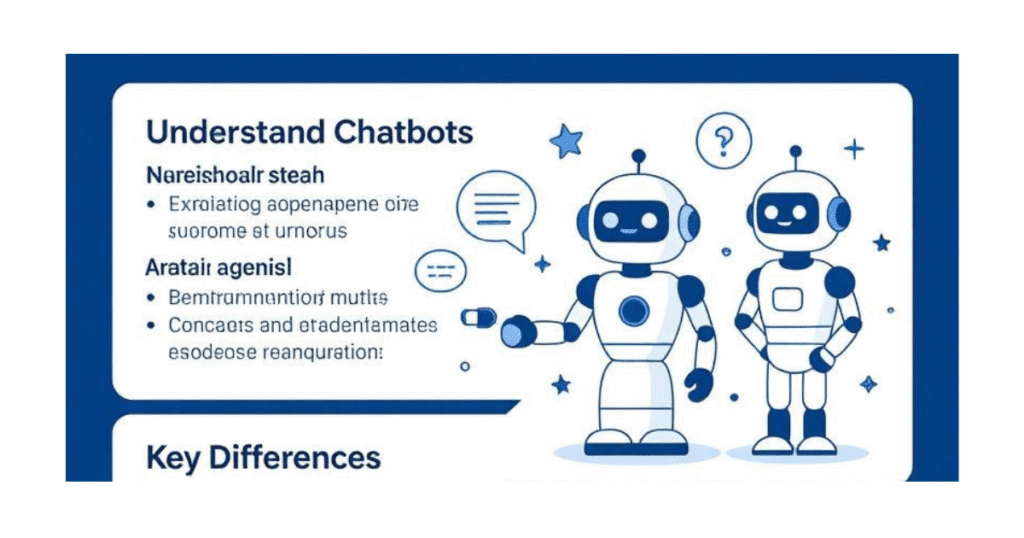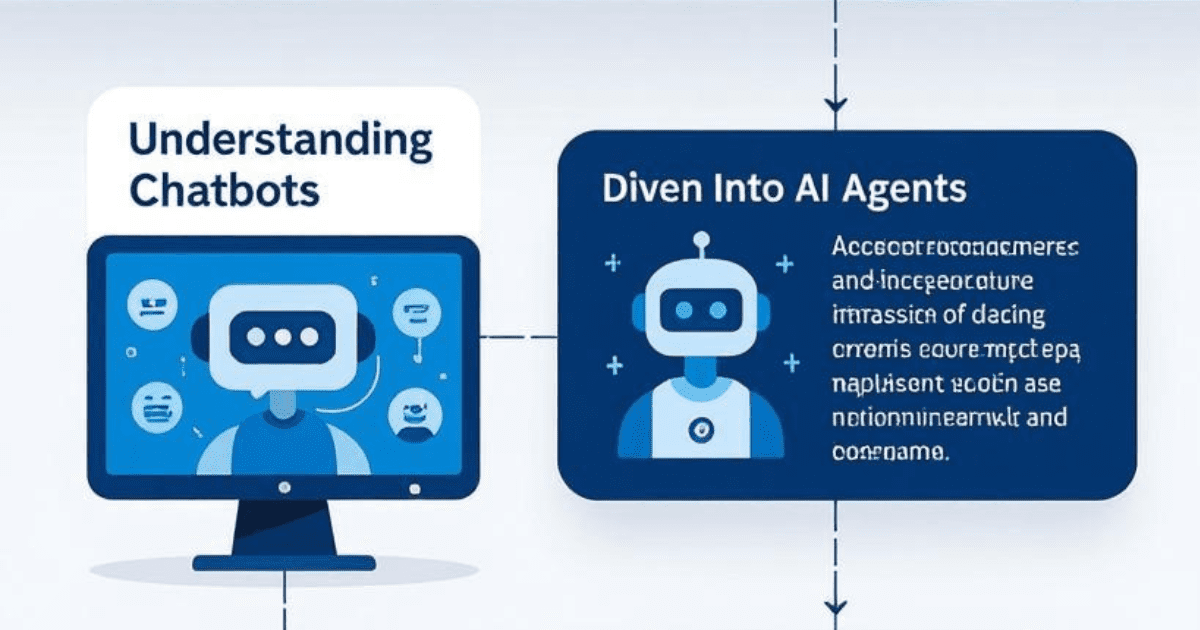In today’s digital world, where automation is king, you’ve probably interacted with some form of AI without even realizing it. Whether it’s asking Siri for the weather or chatting with a customer service bot on a website, these technologies are everywhere. But here’s a question that’s been buzzing around tech circles: what’s the real difference between chatbots and AI agents? If you’re in marketing, business, or just curious about AI, understanding this can help you leverage the right tools for your needs.
Chatbots have been around for a while, handling simple queries like “What’s my order status?” On the flip side, AI agents are the new kids on the block, promising to do more than just talk—they act, learn, and adapt. In this in-depth blog post, we’ll dive deep into the nuances, breaking down definitions, key differences, pros and cons, real-world examples, and future trends. By the end, you’ll have a clear picture of chatbots vs. AI agents and how they fit into our evolving tech landscape.
If you’re searching for “chatbots vs AI agents” or wondering “what is an AI agent,” stick around—this guide is tailored just for you. Let’s get started!
Understanding Chatbots: The Basics
Chatbots are essentially software programs designed to simulate human conversation. They’ve been a staple in customer service and online interactions since the early days of the internet. Remember ELIZA, that 1960s program that mimicked a therapist? That was one of the first chatbots, proving that even basic scripts could fool people into thinking they were talking to a human.
How Do Chatbots Work?
At their core, chatbots rely on predefined rules or simple machine learning algorithms to respond to user inputs. There are two main types:
- Rule-Based Chatbots: These follow a script. If you say “hello,” they respond with “Hi, how can I help?” They’re like decision trees—if this, then that. They’re easy to build and don’t require massive data sets, but they’re limited. Miss a keyword, and they might not understand you.
- AI-Powered Chatbots: These use natural language processing (NLP) to get smarter. Tools like Dialogflow or IBM Watson power them, allowing for more natural conversations. They can handle variations like “What’s the weather?” or “How’s the forecast today?” But even these are reactive—they wait for input and spit out responses based on patterns.
Chatbots shine in structured environments. For instance, on e-commerce sites like Amazon, a chatbot might guide you through returns. They’re cost-effective, available 24/7, and handle high volumes of queries without breaking a sweat.

Pros and Cons of Chatbots
Pros:
- Quick to deploy and inexpensive.
- Great for FAQs and routine tasks.
- Improves customer engagement without human intervention.
Cons:
- Limited to scripted responses; can’t handle complex or unexpected queries.
- Often frustrating if they loop or misunderstand.
- No real learning—each interaction is isolated.
In a nutshell, chatbots are like friendly receptionists: helpful for basics but not for deep dives.
Diving into AI Agents: The Next Level
Now, let’s shift gears to AI agents. If chatbots are receptionists, AI agents are like personal assistants with superpowers. An AI agent is an autonomous system that perceives its environment, makes decisions, and takes actions to achieve specific goals. They’re not just conversational; they’re proactive.
What Makes an AI Agent?
AI agents build on advanced AI technologies like machine learning, reinforcement learning, and sometimes even generative AI. They can:
- Perceive and Adapt: Using sensors or data inputs, they understand context.
- Reason and Plan: They think ahead, breaking down tasks into steps.
- Act Independently: Unlike chatbots, they don’t need constant user prompts.
Types of AI agents include:
- Simple Reflex Agents: React to immediate stimuli, like a thermostat adjusting temperature.
- Model-Based Agents: Use internal models of the world to predict outcomes.
- Goal-Based Agents: Focus on achieving objectives, optimizing paths.
- Utility-Based Agents: Weigh options based on desirability, like in game AI.
- Learning Agents: Improve over time through experience, such as AlphaGo.
Examples? Think of autonomous vehicles like Tesla’s Full Self-Driving mode—they’re AI agents navigating roads, avoiding obstacles, and learning from data. Or in business, tools like AutoGPT or BabyAGI, which can chain tasks: research a topic, summarize it, and even draft an email.
Pros and Cons of AI Agents
Pros:
- Handle complex, multi-step tasks autonomously.
- Learn and improve, making them scalable.
- Versatile across industries, from healthcare to finance.
Cons:
- More expensive and complex to develop.
- Potential ethical issues, like bias or unintended actions.
- Require robust data and computing power.
AI agents represent the future of AI, where machines don’t just respond—they anticipate and execute.
Key Differences Between Chatbots and AI Agents
Alright, now for the meat of the matter: chatbots vs. AI agents. While both use AI to some extent, their differences are stark. Let’s break it down category by category.
1. Functionality and Scope
Chatbots are primarily conversational tools. Their main job is to chat—answer questions, provide info, or guide users through menus. They’re reactive: you ask, they respond. If the query veers off-script, they might say, “Sorry, I don’t understand.”
AI agents, however, are action-oriented. They can perform tasks beyond talking. For example, an AI agent in a smart home might notice you’re low on groceries (via inventory sensors), order them online, and schedule delivery—all without you lifting a finger. The scope is broader: planning, executing, and iterating.
2. Intelligence and Learning Capabilities
Chatbots have limited intelligence. Even NLP-enhanced ones rely on pattern matching. They don’t “learn” from interactions unless reprogrammed by developers. It’s static knowledge.
AI agents thrive on learning. Using algorithms like deep learning, they adapt. A trading AI agent might analyze market data, predict trends, and execute trades, getting better with each cycle. This dynamic intelligence sets them apart.
3. Autonomy and Decision-Making
Autonomy is where AI agents shine. Chatbots need human-like input to function; they’re tools, not independents. An AI agent can operate with minimal supervision, making decisions based on goals. In robotics, an AI agent like Boston Dynamics’ Spot can navigate terrains autonomously, avoiding hazards.
4. Interaction with Environment
Chatbots live in chat windows or apps, interacting solely through text or voice. Their “environment” is the conversation.
AI agents interact with the real or digital world. They use APIs, sensors, or integrations to affect change—booking flights, controlling devices, or even collaborating with other agents.
5. Complexity and Development
Building a chatbot? You can use no-code platforms like Chatfuel or Botpress. It’s straightforward, often taking days.
AI agents require expertise in AI frameworks like TensorFlow or PyTorch. Development involves modeling behaviors, training on data, and testing for edge cases—months or years of work.
6. Use of Data and Privacy
Both handle data, but AI agents process more, raising privacy concerns. Chatbots might log chats for improvement, but agents analyze patterns across systems, needing stricter compliance like GDPR.
In summary, if chatbots are sprinters for quick tasks, AI agents are marathon runners for enduring, complex challenges.
Real-World Examples and Use Cases
To make this tangible, let’s look at examples.
Chatbot Examples
- Customer Service: Banks like Bank of America use Erica, a chatbot for balance checks and transfers.
- E-Commerce: Shopify’s Kit helps with marketing queries.
- Healthcare: Woebot offers mental health chats based on CBT principles.
These handle volume but escalate to humans for complexity.
AI Agent Examples
- Personal Assistants: Google’s Bard or xAI’s Grok (hey, that’s me!) can go beyond chat—generating code, analyzing data, or planning.
- Autonomous Systems: Waymo’s self-driving cars are AI agents perceiving roads and deciding paths.
- Business Automation: Tools like Zapier with AI integrations act as agents, automating workflows.
Industry-Specific Use Cases
- Retail: Chatbots for queries; AI agents for inventory management, predicting stock needs.
- Finance: Chatbots for FAQs; AI agents for fraud detection, analyzing transactions in real-time.
- Healthcare: Chatbots for symptom checkers; AI agents for drug discovery, simulating interactions.
Choosing between them depends on needs—if it’s simple interaction, chatbot; for proactive automation, AI agent.
Advantages, Disadvantages, and When to Choose Each
Advantages of Chatbots
They’re accessible. Small businesses can implement them without big budgets, improving response times and customer satisfaction. Scalable for global audiences, they reduce wait times.
Disadvantages of Chatbots
Frustration from misunderstandings leads to poor UX. They can’t innovate or handle nuance, limiting growth.
Advantages of AI Agents
Efficiency boosters. They free humans for creative work, optimize processes, and provide insights from data. In R&D, they accelerate innovation.
Disadvantages of AI Agents
High costs and risks—like job displacement or errors if not trained well. Ethical dilemmas, such as in military AI agents.
When to Choose Chatbots: For startups or simple support. If your goal is quick, cost-effective engagement.
When to Choose AI Agents: For enterprises needing automation. If tasks involve decision-making or multi-steps.
The Future of Chatbots and AI Agents
The line between chatbots and AI agents is blurring. With advancements in LLMs like GPT-4, chatbots are getting agent-like features—think plugins that let them book reservations.
Trends to watch:
- Hybrid Models: Chatbots evolving into agents with added autonomy.
- Multi-Agent Systems: Agents collaborating, like in swarm robotics.
- Ethical AI: Regulations ensuring safe deployment.
- Integration with IoT: Agents controlling smart devices seamlessly.
By 2030, Gartner predicts 80% of enterprises will use AI agents for operations. Chatbots won’t disappear; they’ll specialize in niches.
Conclusion: Making the Right Choice for Your Needs
So, what’s the difference between chatbots and AI agents? Chatbots are conversational helpers for routine tasks, while AI agents are autonomous powerhouses for complex actions. Both have roles in our AI-driven world, but understanding their strengths helps you pick wisely.
Whether you’re optimizing SEO for your site (hint: integrate a chatbot for user engagement) or automating workflows with agents, the key is alignment with goals. If you’re building one, start small—test a chatbot, then scale to agents.
What do you think? Have you used either? Drop a comment below. For more on AI trends, subscribe to our blog!

